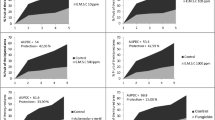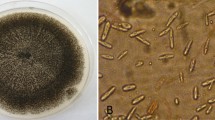Abstract
A new yeast antagonist, Pichia caribbica, isolated in our laboratory from the soil collected from unsprayed orchards, was evaluated for its biocontrol capability against Rhizopus stolonifer on peaches and the possible mechanisms involved. The decay incidence and lesion diameter of Rhizopus decay of peaches treated by P. caribbica were significantly reduced compared with the control fruits, and the higher the concentration of P. caribbica, the better the efficacy of the biocontrol. Rapid colonization of the yeast in peach wounds stored at 25 °C was observed. In peaches, the activities of peroxidase (POD), catalase (CAT), and phenylalanine ammonia-lyase (PAL) were significantly induced by P. caribbica treatment compared to those of the control fruits. All these results indicated that P. caribbica has a great potential for the development of commercial formulations to control postharvest Rhizopus decay of peaches. Its modes of action were based on competition for space and nutrients with pathogens, inducement of activities of defense-related enzymes such as POD, CAT, and PAL of peaches.





Similar content being viewed by others
References
Adaskaveg JE, Michailides TJ (1996) Cancellation of postharvest use of Rovral 50WP on stone fruit crops and other label changes of the fungicide. Cent Vall Postharvest Newslett 5:9–10
Arras G, Arru S (1999) Integrated control of postharvest citrus decay and induction of phytoalexins by Debaryomyces hansenii. Adv Hortic Sci 13:76–81
Calvo J, Calvente V, Orellano ME, Benuzzi D, Tosetti MIS (2007) Biological control of postharvest spoilage caused by Penicillium expansum and Botrytis cinerea in apple by using the bacterium Rahnella aquatilis. Int J Food Microbiol 113:251–257
Caruso C, Chilosi G, Caporale C, Leonardi L, Bertini L, Magro P, Buonocore V (1999) Induction of pathogenesis-related proteins in germinating wheat seeds infected with Fusarium culmorum. Plant Sci 140:87–97
Castoria R, Caputo L, De Curtis F, De Cicco V (2003) Resistance of postharvest biocontrol yeasts to oxidative stress: a possible new mechanism of action. Phytopathology 93:564–572
Droby S, Chalutz E (1994) Mode of action of biocontrol agents of postharvest disease. In: Wilson CL, Wisniewski ME (eds) Biological control of postharvest diseases of fruits and vegetables-theory and practice. CRC Press, Boca Raton, pp 63–75
Droby S, Vinokur V, Weiss B, Cohen L, Daus A, Goldschmidt EE, Porat R (2002) Induction of resistance to Penicillium digitatum in grapefruit by the yeast biocontrol agent Candida oleophila. Phytopathology 92:393–399
El-Ghaouth A, Wilson CL, Wisniewski M (1998) Ultrastructural and cytochemical aspects of the biological control of Botrytis cinerea by Candida saitoana in apple fruit. Biol Control 88:283–291
Fan Q, Tian SP (2000) Postharvest biological control of Rhizopus rot of nectarine fruits by Pichia membranefaciens. Plant Dis 84:1212–1216
Filonow AB (1998) Role of competition for sugars by yeasts in the biocontrol of gray mold of apple. Biocontrol Sci Technol 8:243–256
Fravel DR (2005) Commercialization and implementation of biocontrol. Annu Rev Plant Biol 43:337–359
Hariyadi P, Parkin KL (1991) Chilling-induced oxidative stress in cucumber fruits. Postharvest Biol Technol 1:33–45
He D, Zheng XD, Yin YM, Sun P, Zhang HY (2003) Yeast application for controlling apple postharvest diseases associated with Penicillium expansum. Bot Bull Acad Sinica 44:211–216
Holmes GJ, Eckert JW (1999) Sensitivity of Penicillium digitatum and P. italicum to postharvest citrus fungicides in California. Phytopathology 89:716–721
Hong CX, Michailides TJ, Holtz BA (1998) Effects of wounding, inoculum density and biological control agents on postharvest brown rot of stone fruits. Plant Dis 82:1210–1216
Ippolito A, Ghaouth AE, Wilson CL, Wisniewski M (2000) Control of postharvest decay of apple fruit by Aureobasidium pullulans and induction of defense responses. Postharvest Biol Technol 19:265–272
Janisiewicz WJ, Korsten L (2002) Biological control of postharvest diseases of fruits. Annu Rev Phytopathol 40:411–441
Lee DH, Lee CB (2000) Chilling stress-induced changes of antioxidant enzymes in the leaves of cucumber: in gel enzyme activity assays. Plant Sci 159:75–85
Lima G, Spina AM, Castoria R, De Curtis F, De Cicco V (2005) Integration of biocontrol agents and food-grade additives for enhancing protection of stored apples from Penicillium expansum. J Food Protect 68:2100–2106
Li RP, Zhang HY, Liu WM, Zheng XD (2011) Biocontrol of postharvest gray and blue mold decay of apples with Rhodotorula mucilaginosa and possible mechanisms of action. Int J Food Microbiol 146:151–156
Li SS, Cheng C, Li Z, Chen JY, Yan B, Han BZ, Reeves M (2010) Yeast species associated with wine grapes in China. Int J Food Microbiol 138:85–90
Lurie S, Fallik E, Handros A, Shapira R (1997) The possible involvement of peroxidase in resistance to Botrytis cinereain heat treated tomato fruit. Physiol Mol Plant P 50:141–149
Mclaughlin RJ, Wilson CL, Droby S, Ben-Arie R, Chalutz E (1992) Biological control of postharvest diseases of grape, peach, and apple with the yeasts Kloeckera apiculata and Candida guilliermondii. Plant Dis 76:470–473
Miller AR (2003) Harvest and handing injury: physiology, biochemistry, and deletion. In: Bartz J, Brecht J (eds) Postharvest physiology and pathology of vegetables. Marcel Dekker, New York, pp 177–208
Mittler R (2002) Oxidative stress, antioxidants and stress tolerance. Trends Plant Sci 7:405–410
Prusky D (2003) Mechanism of resistance of fruits and vegetables to postharvest diseases. In: Bartz J, Brecht J (eds) Postharvest physiology and pathology of vegetables. Marcel Dekker, New York, pp 581–598
Sansone G, Rezza I, Calvente V, Benuzzi D, Tosetti MIS (2005) Control of Botrytis cinerea strains resistant to iprodione in apple with rhodotorulic acid and yeasts. Postharvest Biol Technol 35:245–251
Sharma RR, Singh D, Singh R (2009) Biological control of postharvest diseases of fruits and vegetables by microbial antagonists: a review. Biol Control 50:205–221
Su J, Tu K, Cheng L, Tu SC, Wang M, Xu HR, Zhan G (2011) Wound-induced H2O2 and resistance to Botrytis cinerea decline with the ripening of apple fruit. Postharvest Biol Technol 62:64–70
Vero S, Mondino P, Burgueño J, Soubes M, Wisniewski M (2002) Characterization of biocontrol activity of two yeast strains from Uruguay against blue mold of apple. Postharvest Biol Technol 26:91–98
Viñas I, Usall J, Teixidó N, Sanchis V (1998) Biological control of major postharvest pathogens on apple with Candida sake. Int J Food Microbiol 40:9–16
Wang YS, Tian SP, Xu Y, Qin GZ, Yao HJ (2004) Changes in the activities of pro- and anti-oxidant enzymes in peach fruit inoculated with Cryptococcus laurentii or Penicillium expansum at 0 or 20 °C. Postharvest Biol Technol 34:21–28
Wilson CL, Wisniewski ME, Droby S, Chalutz E (1993) A selection strategy for microbial antagonists to control postharvest diseases of fruits and vegetables. Sci Hortic 53:183–189
Xu XM, Bertone C, Berrie A (2007) Effects of wounding, fruit age and wetness duration on the development of cherry brown rot in the UK. Plant Pathol 56:114–119
Zhang HY, Zheng XD, Fu CX, Xi YF (2005) Postharvest biological control of gray mold rot of pear with Cryptococcus laurentii. Postharvest Biol Technol 35:79–86
Zhao LN, Zhang HY, Li J, Cui JH, Zhang XY, Ren XF (2012) Enhancement of biocontrol efficacy of Pichia carribbica to postharvest diseases of strawberries by addition of trehalose to the growth medium. Inter J Mol Sci 13:1916–1932
Acknowledgments
This research was supported by the National Natural Science Foundation of China (31271967), the Research Fund for the Doctoral Program of Higher Education of China (20123227110015), the Technology Support Plan of Jiangsu Province (BE2011395), and the Project Funded by the Priority Academic Program Development of Jiangsu Higher Education Institutions.
Author information
Authors and Affiliations
Corresponding author
Rights and permissions
About this article
Cite this article
Xu, B., Zhang, H., Chen, K. et al. Biocontrol of Postharvest Rhizopus Decay of Peaches with Pichia caribbica . Curr Microbiol 67, 255–261 (2013). https://doi.org/10.1007/s00284-013-0359-9
Received:
Accepted:
Published:
Issue Date:
DOI: https://doi.org/10.1007/s00284-013-0359-9




